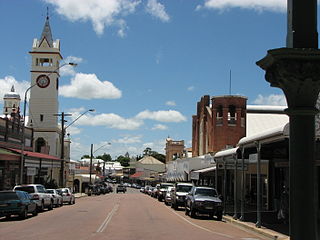
Charters Towers is a rural town in the Charters Towers Region, Queensland, Australia. It is 136 km (85 mi) by road south-west from Townsville on the Flinders Highway. During the last quarter of the 19th century, the town boomed as the rich gold deposits under the city were developed. After becoming uneconomical in the 20th century, profitable mining operations have commenced once again. In the 2016 census, Charters Towers had a population of 8,120 people.
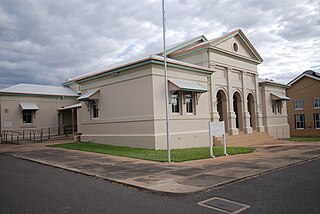
Charters Towers Courthouse is a heritage-listed courthouse at 28 Hodgkinson Street, Charters Towers City, Charters Towers, Charters Towers Region, Queensland, Australia. It was designed by John James Clark and built in 1886 by Charles Miller. It is also known as Charters Towers Courthouse. It was added to the Queensland Heritage Register on 21 October 1992.

Moorlands is a heritage-listed villa at 451 Coronation Drive, Auchenflower, Queensland, Australia. It was designed by Richard Gailey and was built c. 1892 by contractor Arthur Smith. It was added to the Queensland Heritage Register on 21 August 1992.
Astolat is a heritage-listed villa at 96 Kadumba Street, Yeronga, City of Brisbane, Queensland, Australia. It was built from c. 1890 to c. 1890. It was added to the Queensland Heritage Register on 25 August 2000.

Toorak House is a heritage-listed villa at 28 Annie Street, Hamilton, City of Brisbane, Queensland, Australia. It was built from c. 1865 to 1915. It was added to the Queensland Heritage Register on 2 March 1994.

Grand Hotel is a heritage-listed hotel at 39 Central Street, Mount Morgan, Rockhampton Region, Queensland, Australia. It was built c. 1901. It was added to the Queensland Heritage Register on 21 October 1992.

Queensland National Hotel is a heritage-listed former hotel at 28 Morgan Street, Mount Morgan, Rockhampton Region, Queensland, Australia. It was designed by John William Wilson and built in 1890. It is also known as Wesleyan Mission Hall. It was added to the Queensland Heritage Register on 21 October 1992.

Queensland National Bank is a heritage-listed former bank at 295-303 Flinders Street, Townsville CBD, City of Townsville, Queensland, Australia. It was designed by Francis Drummond Greville Stanley and built from 1878 to 1879 by C A Ward. It was added to the Queensland Heritage Register on 28 January 1994.
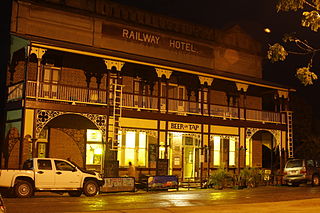
Railway Hotel is a heritage-listed hotel at Barton Street, Ravenswood, Charters Towers Region, Queensland, Australia. It was built c. 1901. It was added to the Queensland Heritage Register on 21 October 1992.

Ravenswood Post Office is a heritage-listed post office at Macrossan Street, Ravenswood, Charters Towers Region, Queensland, Australia. It was built in 1885 by the Queensland Public Works Department. It was added to the Queensland Heritage Register on 21 October 1992.

Thorps Building is a heritage-listed commercial building at Macrossan Street, Ravenswood, Charters Towers Region, Queensland, Australia. It was built c. 1903. It is also known as Burns & Fritz Hardware, Hollimans Limited, and Thorp's Goldfield Tearooms. It was added to the Queensland Heritage Register on 21 October 1992.

Ravenswood Court House and Police Station is a heritage-listed former courthouse and police station at Raven Street, Ravenswood, Charters Towers Region, Queensland, Australia. They were designed by the Queensland Department of Public Works and were built in 1882 by A Donald and FA Sparre. They are also known as Ravenswood Court House Group. They were added to the Queensland Heritage Register on 27 January 1994.

Thornburgh House is a heritage-listed villa at 57–59 King Street, Richmond Hill, Charters Towers, Charters Towers Region, Queensland, Australia. It was built in 1889. It is also known as Thornburgh and Thornburgh College. It was added to the Queensland Heritage Register on 21 October 1992.

Pfeiffer House is a heritage-listed detached house at 2–6 Paull Street, Charters Towers City, Charters Towers, Charters Towers Region, Queensland, Australia. It was built c. 1881. It is also known as Church of Jesus Christ of Latter Day Saints and Day Dawn House. It was added to the Queensland Heritage Register on 21 October 1992.
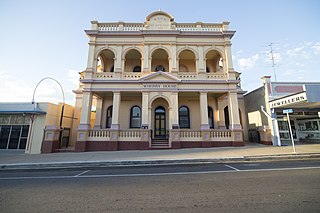
Bank of New South Wales is a heritage-listed former bank building at 34–36 Gill Street, Charters Towers City, Charters Towers, Charters Towers Region, Queensland, Australia. It was designed by Eyre & Munro and built in 1889 by Kelleher. It is also known as Wherry House. It was added to the Queensland Heritage Register on 9 November 2012.

Aldborough is a heritage-listed villa at 25 Deane Street, Charters Towers City, Charters Towers, Charters Towers Region, Queensland, Australia. It was designed by William Henry Allan Munro and built in 1900 by Thomas Barry O'Meara. It was added to the Queensland Heritage Register on 14 August 2008.

Civic Club is a heritage-listed club house at 36 Ryan Street, Charters Towers City, Charters Towers, Charters Towers Region, Queensland, Australia. It was built in 1900. It is also known as Londoners' Club. It was added to the Queensland Heritage Register on 21 October 1992.

Church of Christ is a heritage-listed church at Anne Street, Charters Towers City, Charters Towers, Charters Towers Region, Queensland, Australia. It was built from 1885 to 1887. It is also known as St Johannes Lutheran Church and The "German Church". It was added to the Queensland Heritage Register on 28 May 1999.

Charters Towers Police Station is a heritage-listed police station at 49 Gill Street, Charters Towers City, Charters Towers, Charters Towers Region, Queensland, Australia. It was designed by Thomas Pye and built in 1910 by T Johnson. It is also known as Police Barracks. It was added to the Queensland Heritage Register on 21 October 1992.
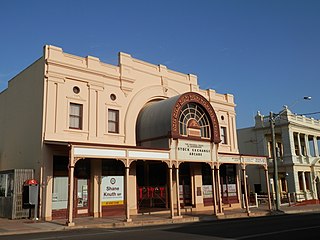
Charters Towers City is the central suburb and central business district of the town of Charters Towers in the Charters Towers Region, Queensland, Australia. In the 2016 census, Charters Towers City had a population of 2,134 people.






















